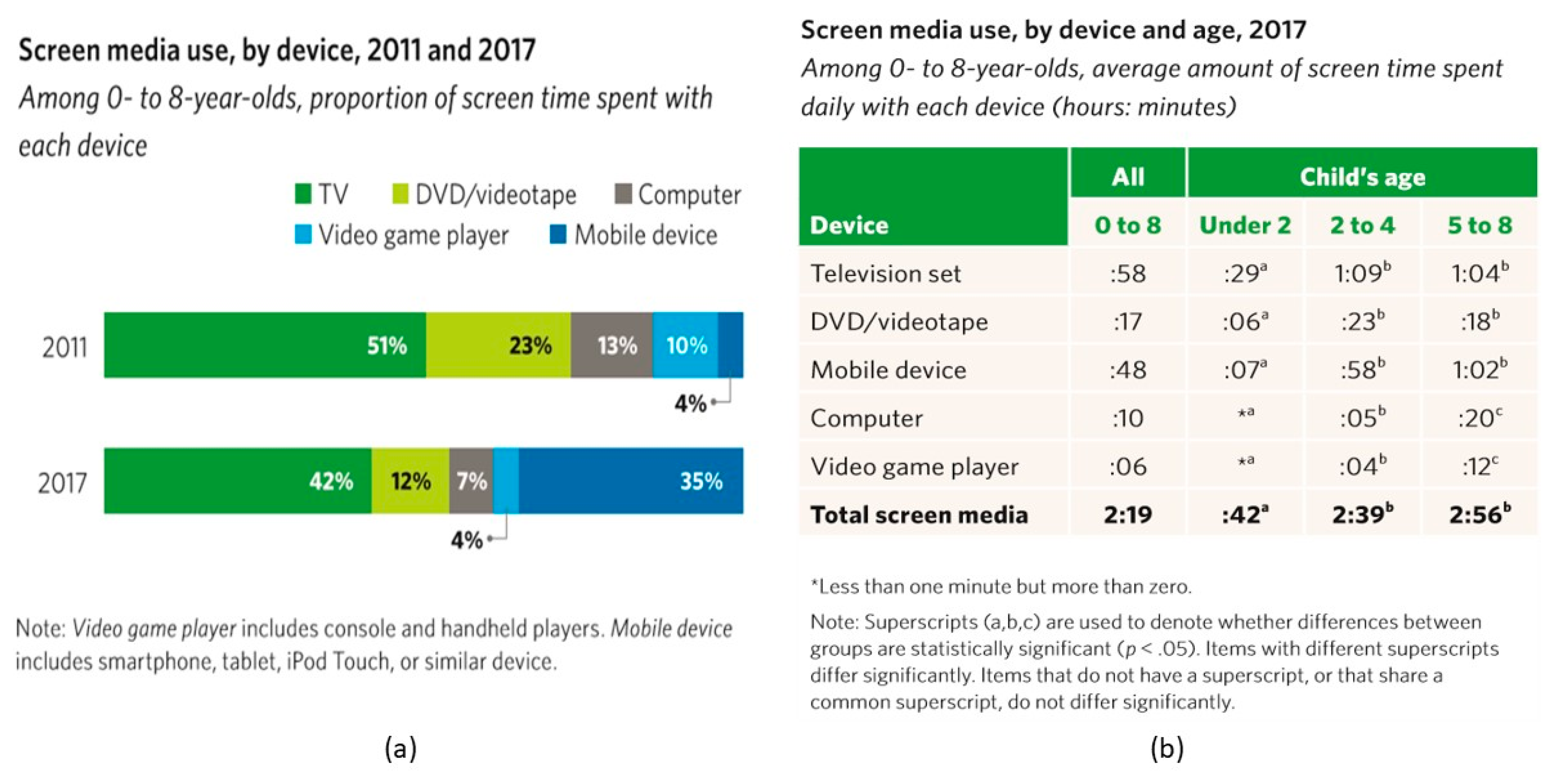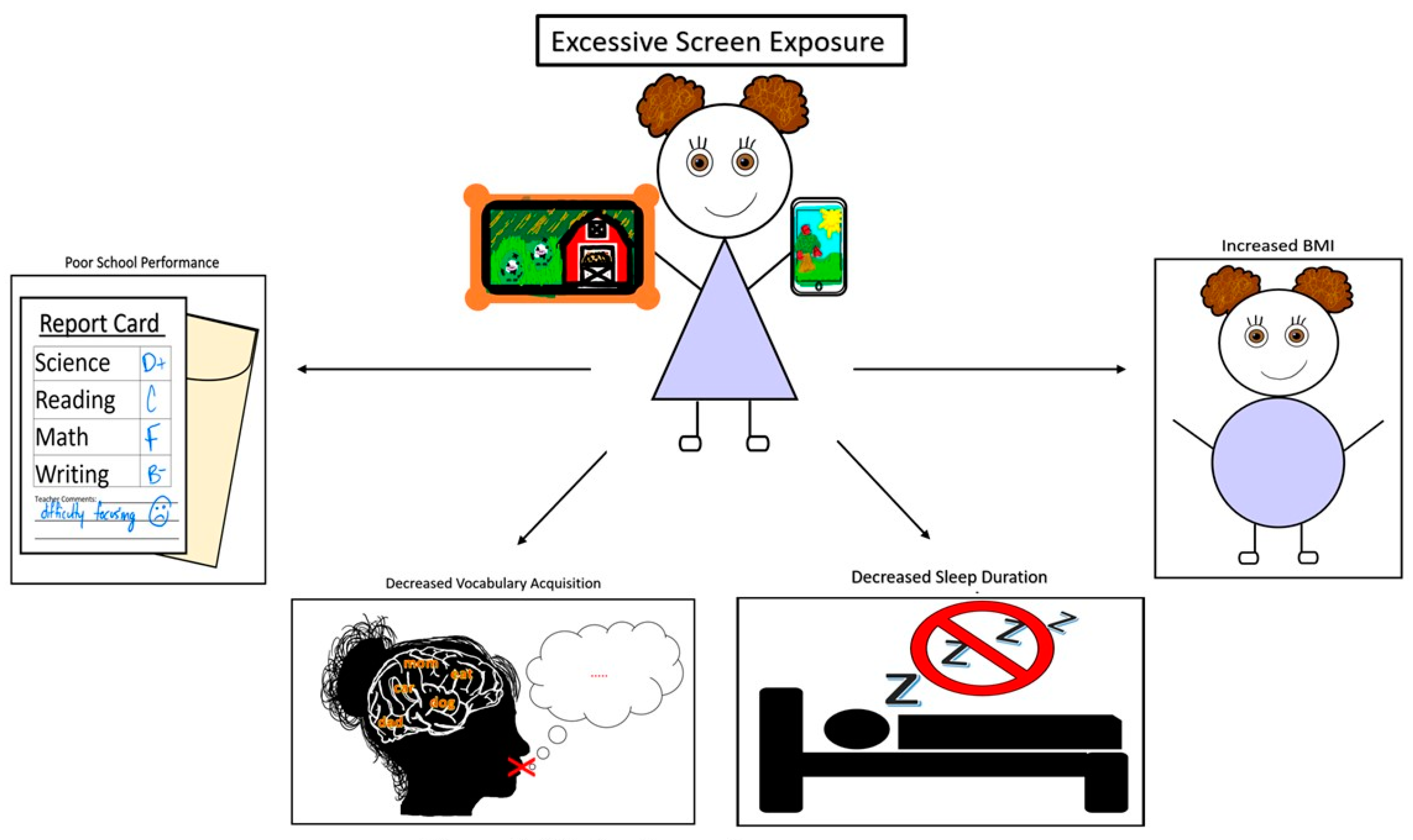Children’s Environmental Health in the Digital Era: Understanding Early Screen Exposure as a Preventable Risk Factor for Obesity and Sleep Disorders
Abstract
:1. Introduction
2. Review of the Literature
2.1. Potential Biological Effects of Early Screen Exposure
2.2. Early Screen Exposure and Sleep
2.3. Early Screen Exposure and Obesity
3. Discussion
3.1. Current Recommendations
3.2. Effects of Early Screen Exposure
3.3. Future Direction
Author Contributions
Conflicts of Interest
References
- Wells, L. Children and Television. Available online: http://iml.jou.ufl.edu/projects/Spring03/Wells/home.htm (accessed on 22 November 2017).
- Anderson, D.R.; Pempek, T.A. Television and Very Young Children. Am. Behav. Sci. 2005, 48, 502–522. [Google Scholar] [CrossRef]
- Courage, M.L.; Setliff, A.E. When babies watch television: Attention-getting, attention-holding, and the implications for learning from video material. Dev. Rev. 2010, 30, 220–238. [Google Scholar] [CrossRef]
- Zimmerman, F.J.; Christakis, D.A.; Meltzoff, A.N. Television and DVD/video viewing in children younger than 2 years. Arch. Pediatr. Adolesc. Med. 2007, 161, 473–479. [Google Scholar] [CrossRef] [PubMed]
- Lapierre, M.A.; Piotrowski, J.T.; Linebarger, D.L. Background television in the homes of US children. Pediatrics 2012, 130, 839–846. [Google Scholar] [CrossRef] [PubMed]
- Christakis, E. The Importance of Being Little: What Young Children Really Need from Grownups; Penguin Books: New York, NY, USA, 2017. [Google Scholar]
- Council on Communications and Media. Media and Young Minds. Pediatrics 2016, 138, e20162591. [Google Scholar] [CrossRef]
- Kids’ Audience Behavior Across Platforms. Available online: http://www.nielsen.com/us/en/insights/reports/2015/kids-audience-behavior-across-platforms.html (accessed on 23 November 2017).
- Rideout, V. The Common Sense Census: Media Use by Kids Age Zero to Eight; Robb, M., Ed.; Common Sense Media: San Francisco, CA, USA, 2017. [Google Scholar]
- Kirkorian, H.L.; Wartella, E.A.; Anderson, D.R. Media and young children’s learning. Future Child 2008, 18, 39–61. [Google Scholar] [CrossRef] [PubMed]
- Felt, L.J.; Robb, M.B. Technology Addiction: Concern, Controversy, and Finding Balance; Common Sense Media: San Francisco, CA, USA, 2016. [Google Scholar]
- Sigman, A. Visual voodoo: The biological impact of watching TV. Biologist 2007, 54, 12–17. [Google Scholar]
- Day, J.J.; Roitman, M.F.; Wightman, R.M.; Carelli, R.M. Associative learning mediates dynamic shifts in dopamine signaling in the nucleus accumbens. Nat. Neurosci. 2007, 10, 1020–1028. [Google Scholar] [CrossRef] [PubMed]
- Berk, L. Infants and Children: Prenatal through Middle Childhood, 6th ed.; Boston Pearson/Allyn and Bacon: Boston, MA, USA, 2008. [Google Scholar]
- Huttenlocher, P.R. Neural Plasticity: The Effects of the Environment on the Development of the Cerebral Cortex; Harvard University Press: London, UK, 2002. [Google Scholar]
- Duch, H.; Fisher, E.M.; Ensari, I.; Font, M.; Harrington, A.; Taromino, C.; Yip, J.; Rodriguez, C. Association of screen time use and language development in Hispanic toddlers: A cross-sectional and longitudinal study. Clin. Pediatr. 2013, 52, 857–865. [Google Scholar] [CrossRef] [PubMed]
- Zimmerman, F.J.; Christakis, D.A.; Meltzoff, A.N. Associations between media viewing and language development in children under age 2 years. J. Pediatr. 2007, 151, 364–368. [Google Scholar] [CrossRef] [PubMed]
- Tomopoulos, S.; Dreyer, B.P.; Berkule, S.; Fierman, A.H.; Brockmeyer, C.; Mendelsohn, A.L. Infant Media Exposure and Toddler Development. Arch. Pediatr. Adolesc. Med. 2010, 164, 1105–1111. [Google Scholar] [CrossRef] [PubMed]
- Armstrong, G.B.; Greenberg, B.S. Background television as an inhibitor of cognitive processing. Hum. Commun. Res. 1990, 16, 355–386. [Google Scholar] [CrossRef]
- Ma, J.; van den Heuvel, M.; Maguire, J.; Parkin, P.; Birken, C. Is handheld screen time use associated with language delay in infants? In Proceedings of the Pediatric Academic Societies Meeting, San Francisco, CA, USA, 6–9 May 2017. [Google Scholar]
- Nathanson, A.I.; Aladé, F.; Sharp, M.L.; Rasmussen, E.E.; Christy, K. The relation between television exposure and executive function among preschoolers. Dev. Psychol. 2014, 50, 1497–1506. [Google Scholar] [CrossRef] [PubMed]
- Pagani, L.S.; Fitzpatrick, C.; Barnett, T.A.; Dubow, E. Prospective associations between early childhood television exposure and academic, psychosocial, and physical well-being by middle childhood. Arch. Pediatr. Adolesc. Med. 2010, 164, 425–431. [Google Scholar] [CrossRef] [PubMed]
- Moreira, G.A.; Pradella-Hallinan, M. Sleepiness in Children: An Update. Sleep Med. Clin. 2017, 12, 407–413. [Google Scholar] [CrossRef] [PubMed]
- BaHammam, A.; Al-Faris, E.; Shaikh, S.; Saeed, A.B. Sleep problems/habits and school performance in elementary school children. Sleep Hypn. 2006, 8, 12–18. [Google Scholar]
- Takahashi, Y.; Kipnis, D.M.; Daughaday, W.H. Growth hormone secretion during sleep. J. Clin. Investig. 1968, 47, 2079–2090. [Google Scholar] [CrossRef] [PubMed]
- Tikotzky, L.; DE Marcas, G.; Har-Toov, J.; Dollberg, S.; Bar-Haim, Y.; Sadeh, A. Sleep and physical growth in infants during the first 6 months. J. Sleep Res. 2010, 19, 103–110. [Google Scholar] [CrossRef] [PubMed]
- Touchette, E.; Petit, D.; Séguin, J.R.; Boivin, M.; Tremblay, R.E.; Montplaisir, J.Y. Associations between sleep duration patterns and behavioral/cognitive functioning at school entry. Sleep 2007, 30, 1213–1219. [Google Scholar] [CrossRef] [PubMed]
- Polos, P.G.; Bhat, S.; Gupta, D.; O’Malley, R.J.; DeBari, V.A.; Upadhyay, H.; Chaudhry, S.; Nimma, A.; Pinto-Zipp, G.; Chokroverty, S. The impact of Sleep Time-Related Information and Communication Technology (STRICT) on sleep patterns and daytime functioning in American adolescents. J. Adolesc. 2015, 44, 232–244. [Google Scholar] [CrossRef] [PubMed]
- Cespedes, E.M.; Gillman, M.W.; Kleinman, K.; Rifas-Shiman, S.L.; Redline, S.; Taveras, E.M. Television Viewing, Bedroom Television, and Sleep Duration from Infancy to Mid-Childhood. Pediatrics 2014, 133, 1163–1171. [Google Scholar] [CrossRef] [PubMed]
- Cheung, C.H.M.; Bedford, R.; Saez De Urabain, I.R.; Karmiloff-Smith, A.; Smith, T.J. Daily touchscreen use in infants and toddlers is associated with reduced sleep and delayed sleep onset. Sci. Rep. 2017, 7, 46104. [Google Scholar] [CrossRef] [PubMed]
- Vijakkhana, N.; Wilaisakditipakorn, T.; Ruedeekhajorn, K.; Pruksananonda, C.; Chonchaiya, W. Evening media exposure reduces night-time sleep. Acta Paediatr. 2015, 104, 306–312. [Google Scholar] [CrossRef] [PubMed]
- Owens, J.A.; Adolescent Sleep Working Group; Committee on Adolescence. Insufficient sleep in adolescents and young adults: An update on causes and consequences. Pediatrics 2014, 134, 921–932. [Google Scholar] [CrossRef] [PubMed]
- Garrison, M.M.; Liekweg, K.; Christakis, D.A. Media Use and Child Sleep: The Impact of Content, Timing, and Environment. Pediatrics 2011, 128, 29–35. [Google Scholar] [CrossRef] [PubMed]
- Adams, S.K.; Daly, J.F.; Williford, D.N. Adolescent sleep and cellular phone use: Recent trends and implications for research. Health Serv. Insights 2013, 6, 99–103. [Google Scholar] [PubMed]
- Lemola, S.; Perkinson-Gloor, N.; Brand, S.; Dewald-Kaufmann, J.F.; Grob, A. Adolescents’ electronic media use at night, sleep disturbance, and depressive symptoms in the smartphone age. J. Youth Adolesc. 2015, 44, 405–418. [Google Scholar] [CrossRef] [PubMed]
- Committee on Accelerating Progress in Obesity Prevention; Food and Nutrition Board; Institute of Medicine. Accelerating Progress in Obesity Prevention: Solving the Weight of the Nation; Glickman, D., Parker, L., Sim, L.J., Del Valle Cook, H., Miller, E.A., Eds.; National Academies Press: Washington, DC, USA, 2012.
- Ogden, C.L.; Carroll, M.D.; Lawman, H.G.; Fryar, C.D.; Kruszon-Moran, D.; Kit, B.K.; Flegal, K.M. Trends in Obesity Prevalence Among Children and Adolescents in the United States, 1988–1994 Through 2013–2014. JAMA 2016, 315, 2292–2299. [Google Scholar] [CrossRef] [PubMed]
- Fryar, C.D.; Carroll, M.D.; Ogden, C.L. Prevalence of Overweight and Obesity among Children and Adolescents: United States, 1963–1965 through 2011–2012; National Center for Health Statistics: Atlanta, GA, USA, 2014.
- Must, A.; Hollander, S.A.; Economos, C.D. Childhood obesity: A growing public health concern. Expert Rev. Endocrinol. Metab. 2006, 1, 233–254. [Google Scholar] [CrossRef]
- Freedman, D.S.; Mei, Z.; Srinivasan, S.R.; Berenson, G.S.; Dietz, W.H. Cardiovascular risk factors and excess adiposity among overweight children and adolescents: The Bogalusa Heart Study. J. Pediatr. 2007, 150, 12–17. [Google Scholar] [CrossRef] [PubMed]
- An, R.; Yan, H.; Shi, X.; Yang, Y. Childhood obesity and school absenteeism: A systematic review and meta-analysis. Obes. Rev. 2017, 18, 1412–1424. [Google Scholar] [CrossRef] [PubMed]
- Taras, H.; Potts-Datema, W. Obesity and student performance at school. J. Sch. Health 2005, 75, 291–295. [Google Scholar] [CrossRef] [PubMed]
- Serdula, M.K.; Ivery, D.; Coates, R.J.; Freedman, D.S.; Williamson, D.F.; Byers, T. Do obese children become obese adults? A review of the literature. Prev. Med. 1993, 22, 167–177. [Google Scholar] [CrossRef] [PubMed]
- White House Task Force on Childhood Obesity Report to the President. Solving the Problem of Childhood Obesity within a Generation, 2010. Let’s Move. Available online: https://letsmove.obamawhitehouse.archives.gov/white-house-task-force-childhood-obesity-report-president (accessed on 22 November 2017).
- Hoelscher, D.M.; Kirk, S.; Ritchie, L.; Cunningham-Sabo, L. Position of the Academy of Nutrition and Dietetics: Interventions for the prevention and treatment of pediatric overweight and obesity. J. Acad. Nutr. Diet 2013, 113, 1375–1394. [Google Scholar] [CrossRef] [PubMed]
- Schwartz, A.R.; Patil, S.P.; Laffan, A.M.; Polotsky, V.; Schneider, H.; Smith, P.L. Obesity and Obstructive Sleep Apnea: Pathogenic Mechanisms and Therapeutic Approaches. Proc. Am. Thorac. Soc. 2008, 5, 185–192. [Google Scholar] [CrossRef] [PubMed]
- Dietz, W.H.; Gortmaker, S.L. Do We Fatten Our Children at the Television Set? Obesity and television viewing in children and adolescents. Pediatrics 1985, 75, 807–812. [Google Scholar] [PubMed]
- Gortmaker, S.L.; Must, A.; Sobol, A.M.; Peterson, K.; Colditz, G.A.; Dietz, W.H. Television viewing as a cause of increasing obesity among children in the United States, 1986–1990. Arch. Pediatr. Adolesc. Med. 1996, 150, 356–362. [Google Scholar] [CrossRef] [PubMed]
- Robinson, T.N. Television viewing and childhood obesity. Pediatr. Clin. North Am. 2001, 48, 1017–1025. [Google Scholar] [CrossRef]
- Taheri, S.; Lin, L.; Austin, D.; Young, T.; Mignot, E. Short Sleep Duration Is Associated with Reduced Leptin, Elevated Ghrelin, and Increased Body Mass Index. PLoS Med. 2004, 1, e62. [Google Scholar] [CrossRef] [PubMed]
- De Jong, E.; Visscher, T.L.; HiraSing, R.A.; Heymans, M.W.; Seidell, J.C.; Renders, C.M. Association between TV viewing, computer use and overweight, determinants and competing activities of screen time in 4- to 13-year-old children. Int. J. Obes. 2013, 37, 47–53. [Google Scholar] [CrossRef] [PubMed]
- Wen, L.M.; Baur, L.A.; Rissel, C.; Xu, H.; Simpson, J.M. Correlates of body mass index and overweight and obesity of children aged 2 years: Findings from the healthy beginnings trial. Obesity 2014, 22, 1723–1730. [Google Scholar] [CrossRef] [PubMed]
- Peck, T.; Scharf, R.J.; Conaway, M.R.; DeBoer, M.D. Viewing as little as 1 h of TV daily is associated with higher change in BMI between kindergarten and first grade. Obesity 2015, 23, 1680–1686. [Google Scholar] [CrossRef] [PubMed]


| Age | American Academy of Pediatrics Recommendation |
|---|---|
| 0–18 months | No screen time except video chatting |
| 18–24 months | High quality programming/apps with active adult interaction |
| 2–5 years old | One hour of quality programming/apps co-viewed with an adult |
| No screens during meals | |
| No screens at least 1 h before bedtime | |
| Turn off television and other devices when not in use | |
© 2018 by the authors. Licensee MDPI, Basel, Switzerland. This article is an open access article distributed under the terms and conditions of the Creative Commons Attribution (CC BY) license (http://creativecommons.org/licenses/by/4.0/).
Share and Cite
Wolf, C.; Wolf, S.; Weiss, M.; Nino, G. Children’s Environmental Health in the Digital Era: Understanding Early Screen Exposure as a Preventable Risk Factor for Obesity and Sleep Disorders. Children 2018, 5, 31. https://doi.org/10.3390/children5020031
Wolf C, Wolf S, Weiss M, Nino G. Children’s Environmental Health in the Digital Era: Understanding Early Screen Exposure as a Preventable Risk Factor for Obesity and Sleep Disorders. Children. 2018; 5(2):31. https://doi.org/10.3390/children5020031
Chicago/Turabian StyleWolf, Candice, Seth Wolf, Miriam Weiss, and Gustavo Nino. 2018. "Children’s Environmental Health in the Digital Era: Understanding Early Screen Exposure as a Preventable Risk Factor for Obesity and Sleep Disorders" Children 5, no. 2: 31. https://doi.org/10.3390/children5020031




